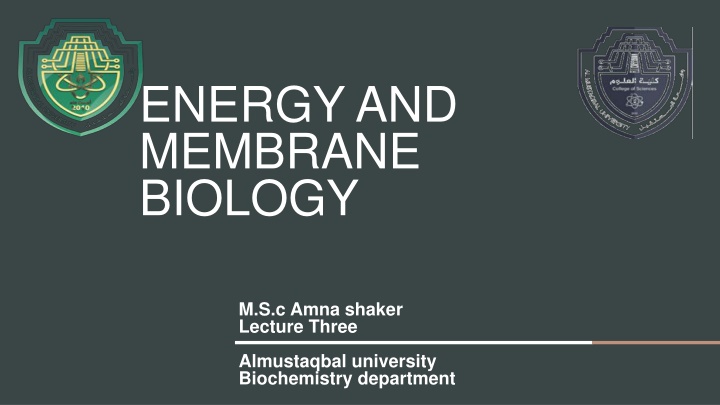
Energy and Membrane Biology: Transport Mechanisms and Cell Function
Explore the essential membrane transport mechanisms and their role in maintaining cell function and homeostasis. Learn about passive and active transport, endocytosis, exocytosis, and the crucial role of osmosis and aquaporins in water movement across cell membranes.
Download Presentation

Please find below an Image/Link to download the presentation.
The content on the website is provided AS IS for your information and personal use only. It may not be sold, licensed, or shared on other websites without obtaining consent from the author. If you encounter any issues during the download, it is possible that the publisher has removed the file from their server.
You are allowed to download the files provided on this website for personal or commercial use, subject to the condition that they are used lawfully. All files are the property of their respective owners.
The content on the website is provided AS IS for your information and personal use only. It may not be sold, licensed, or shared on other websites without obtaining consent from the author.
E N D
Presentation Transcript
ENERGY AND MEMBRANE BIOLOGY M.S.c Amna shaker Lecture Three Almustaqbal university Biochemistry department
Energy and membrane biology 2 MEMBRANE TRANSPORT MECHANISMS Membrane transport mechanisms are essential for maintaining homeostasis and proper cell function. the main type of transport : 1-Passive Transport 2-Active Transport 3-Endocytosis and Exocytosis
3 1-Passive Transport A-Simple Diffusion: Movement of molecules from high to low concentration without energy input. B-Facilitated Diffusion: Uses transport proteins to move molecules across the membrane. C-Osmosis: Diffusion of water across a selectively permeable membrane.
4 2- Active Transport A-Primary Active Transport: Direct use of ATP to transport molecules against their concentration gradient (e.g., Na /K pump). B-Secondary Active Transport: Uses the energy from an electrochemical gradient created by primary active transport. 3-Endocytosis and Exocytosis A-Endocytosis: Cell engulfs external materials using vesicles (e.g., phagocytosis, pinocytosis). B-Exocytosis: Vesicles fuse with the plasma membrane to release contents outside the cel
Energy and membrane biology 5 transport mechanisms The Transport mechanisms plays a crucial role in regulating the movement of substances in and out of cells. How the membrane cell transport the water? 1. Osmosis is the diffusion of water through a selectively permeable membrane from a region of lower solute concentration to a region of higher solute concentration. The cell membrane allows water to pass through while restricting the movement of most solutes. This process helps maintain the cell's internal environment and is crucial for cell survival. 2. Aquaporins are specialized water channel proteins embedded in the cell membrane. They allow water molecules to move in and out of the cell more efficiently than by osmosis alone. These channels are essential for cells that require rapid water transport, such as kidney cells and red blood cell
Presentation title 11 DUTIES ANSWER THE FALLOWING Numerate the differences between active and passive transport ? What type of transport in kidney cells and red blood cell? Define the Endocytosis and Exocytosis ?
THANK YOU






















